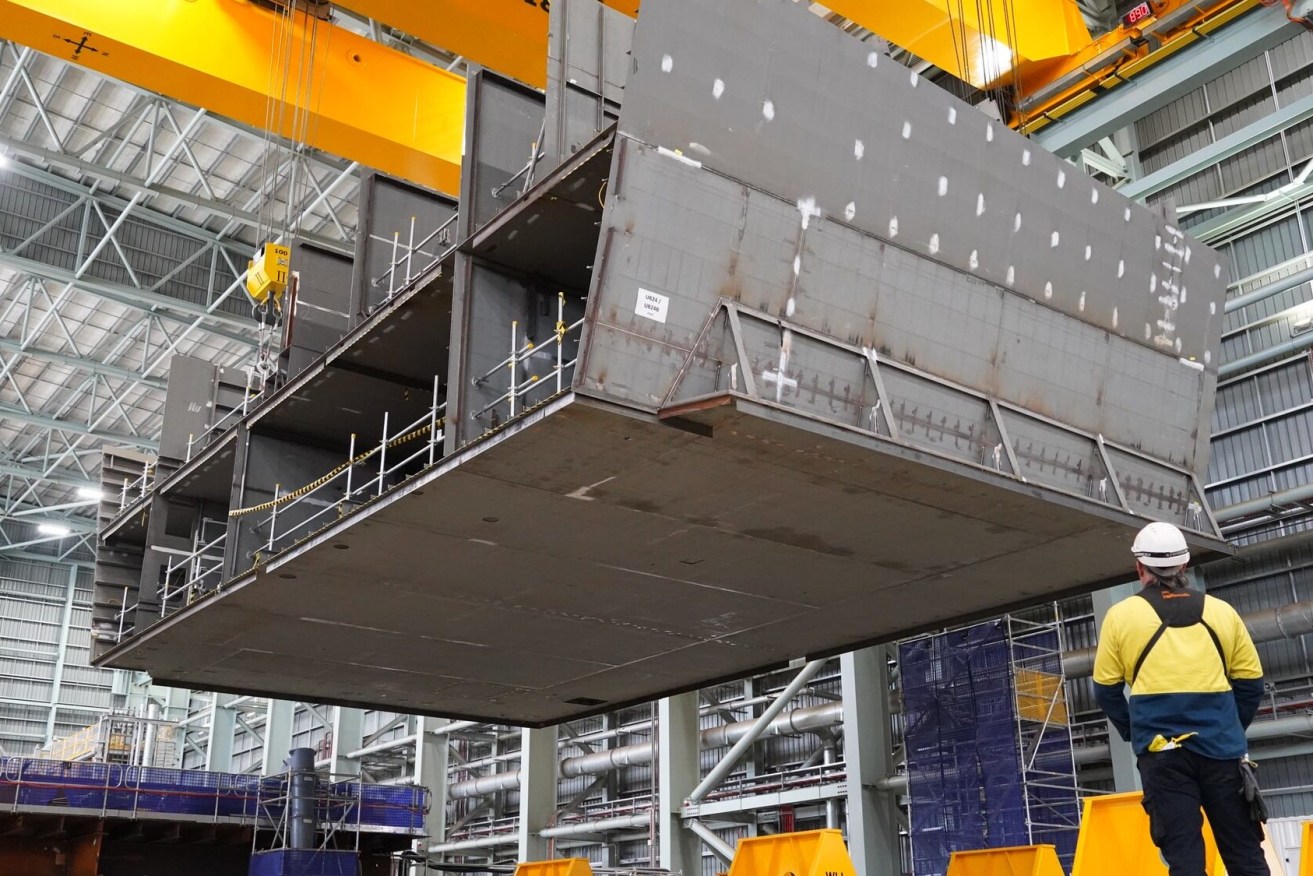Steel cut on final test module for $44 billion frigate project
Steel has been cut on the fifth and final prototype block for the $44 billion submarine-hunting Hunter Class Frigates being built in Adelaide, with work on track to begin the first ship next year. Watch the video.

A prototype block for the Hunter Class Frigates at Osborne in 2018. Photo: BAE Systems
BAE Systems Australia program head Dean Wright said initial work at the state-of-the-art shipyard in Osborne was proving incredibly precise with steel cuts and new welding processes as new workers were trained and processes trialled to ensure more seamless builds.
“In this part of the project we have about 50,000 parts to prototype, there are 4,500 pipes to prototype alone,” Wright said.
Controversy recently surrounded the nation’s largest surface shipbuilding program in defence history, after the Federal Government announced a delay in construction with BAE Systems blaming supply chain issues.
Defence Minister Richard Marles has since pledged the first Hunter class frigate would roll into the water in 2031 and he was working with BAE Systems Australia to see if that date could be earlier.
There are now 1500 people working on the project, mainly in Osborne but also in Melbourne and the United Kingdom, with Wright saying the first steel prototype block of the Hunter-class frigates was completed in August this year.

Building the Hunter Class Frigates. Dean Wright and Molly Davidson at the BAE Systems shipyard at Osborne. Picture: BAE Systems
Wright said there are 22 blocks in each Hunter class frigate, with the first prototype block known as Block 16 weighing more than 140 tonnes and construction involving the expertise of 35 different trades.
Each prototype block is being built so the shipyard can prepare its workforce and incorporate new, more efficient ship-build methods into the process. The final two prototype blocks will actually be used in one of the first three ships.
The frigates are designed to hunt submarines and will be equipped with an Aegis combat system, CEA radar along with sensors, guided weapons and electronic warfare and aviation systems.
Among suppliers are two South Australian businesses, Century Engineering and MG Engineering, with BAE Systems Australia maritime project director Alastair Bacon saying all suppliers were being connected to the project digitally to increase efficiency.
“(This means) we can track and trace their components throughout the process of manufacture and onto site in the shipyard,” Bacon said.
Prototypes are being built onsite at a 360,000sqm, $535 million expansion and redevelopment of the Osborne Naval Shipyard – South where there are now four main structures.
[solstice_jwplayer mediaid=”SGN0X7C0″ caption=”A fly through of the naval shipyard at Osborne. Supplied: BAE Systems Australia” /]
Work begins in the steel fabrication and assembly hall. There is also a block consolidation hall and a 187m long, 50m tall building where the blocks are brought together and outfitted. There also is a blast and paint chamber.
“This is part of the legacy we are leaving this state, this site isn’t Hunter specific so continuous naval shipbuilding can continue in Adelaide,” Wright said.
Prototype and delivery manager Molly Davidson first worked on the Air Warfare Destroyer program at Osborne and has been working with BAE Systems for the past two years.
“I think the scale of this project is amazing, how many people are involved, a lot of our team are in the United Kingdom, we are working with them regularly, it really is a global program and this is good for the economy of the state,” Davidson said.
As state-of-the-art technology is put through its paces at the BAE Systems Australia shipyard, Federal Industry Minister Ed Husic has announced $10.1 million in the budget would expand the linked Flinders University Factory of the Future at Tonsley Innovation District.
Husic said the Factory of the Future would work with more than 200 small-to-medium enterprises to build their technological capabilities and help them gain a foothold in critical supply chains.
“We want Australia to be a country that makes things both now and well into the future,” he said.
“The state-of-the art facility will help develop a dedicated workforce to bridge skills gaps in digital and advanced manufacturing technologies.”




